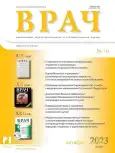Modern view on the problem of keloid scars
- Authors: Dvoriankova E.V.1,2, Korsunskaya I.M.3, Karapetyan M.M.4, Shevchenko G.A.5
-
Affiliations:
- Center for Theoretical Problems of Physicochemical Pharmacology, Russian
- Academy of Sciences Bashkir State Medical University
- Center for Theoretical Problems of Physicochemical Pharmacology, Russian Academy of Sciences
- Moscow Research and Practical Center of Dermatovenereology and Cosmetology
- Peoples’ Friendship University of Russia
- Issue: Vol 34, No 10 (2023)
- Pages: 18-20
- Section: Lecture
- URL: https://journals.eco-vector.com/0236-3054/article/view/117241
- DOI: https://doi.org/10.29296/25877305-2023-10-03
- ID: 117241
Cite item
Abstract
Serious skin injuries can lead to the formation of scars, in particular hypertrophic and keloid scars. The prevalence of keloids and hypertrophic scars varies among different populations.
Scar formation is a natural process during wound healing, but when keloid scars form, regeneration is impaired. It is generally accepted that a keloid scar is formed as a result of increased synthesis of collagen and extracellular matrix against the background of reduced degradation of these products. Clinically, keloid and hypertrophic scars have a number of differences. Thus, the formation of a keloid scar takes a longer period; it extends beyond the boundaries of the original wound and is often accompanied by itching, pain, and impairs motor function. Treatment of keloid scars is a very difficult task, and inadequate treatment can aggravate the patient's condition.
Full Text
About the authors
E. V. Dvoriankova
Center for Theoretical Problems of Physicochemical Pharmacology, Russian; Academy of Sciences Bashkir State Medical University
Email: marykor@bk.ru
ORCID iD: 0000-0002-2458-419X
Doctor of Medical Sciences
Russian Federation, Moscow; UfaI. M. Korsunskaya
Center for Theoretical Problems of Physicochemical Pharmacology, Russian Academy of Sciences
Author for correspondence.
Email: marykor@bk.ru
ORCID iD: 0000-0002-6583-0318
Doctor of Medical Sciences, Professor
Russian Federation, MoscowM. M. Karapetyan
Moscow Research and Practical Center of Dermatovenereology and Cosmetology
Email: marykor@bk.ru
ORCID iD: 0000-0002-4862-2779
Russian Federation, Moscow
G. A. Shevchenko
Peoples’ Friendship University of Russia
Email: marykor@bk.ru
ORCID iD: 0000-0002-2572-2312
Russian Federation, Moscow
References
- Sund B. New Development in Wound Care. PJB Publications; London, UK, 2000; pp. 1–255.
- Chiang R.S., Borovikova A.A., King K. et al. Current concepts related to hypertrophic scarring in burn injuries. Wound Repair Regen. 2016; 24: 466–77. doi: 10.1111/wrr.12432
- Rockwell W.B., Cohen I.K., Ehrlich H.P. Keloids and hypertrophic scars: a comprehensive review. Plast Reconstr Surg. 1998; 84: 827–37. doi: 10.1097/00006534-198911000-00021
- Sun L.-M., Wang K.-H., Lee Y.-C.G. Keloid incidence in Asian people and its comorbidity with other fibrosis-related diseases: a nationwide population-based study. Arch Dermatol Res. 2014; 306: 803–8. doi: 10.1007/s00403-014-1491-5
- Eming S.A. Biology of wound healing. In: Bolognia J.L., Schaffer J.V., Cerroni L., ed. Dermatology. 4th ed. Philadelphia, PA: Elsevier, 2018; рр. 2413–24.
- Мелконян К.И., Бирюкова А.О., Улитина Н.Н. и др. Компоненты внеклеточного матрикса в восстановлении поврежденных тканей: биохимические взаимодействия и протективный эффект. Крымский журнал экспериментальной и клинической медицины. 2019; 9 (4): 55–62 [Melkonyan K.I., Biryukova A.O., Ulitina N.N. et al. Extracellular matrix components in repair of damaged tissues: biochemical interactions and protective effect. Crimean Journal of Experimental and Clinical Medicine. 2019; 9 (4): 55–62 (in Russ.)].
- Chu E.A., Byrne P.J., Odland R.M. et al. Cummings Otolaryngology. Philadelphia, PA: W.B. Saunders, 2015; рр 1124–36.
- Hu M.S., Longaker M.T., Lorenz H.P. et al. Scar Prevention, Treatment, and Revision, in Neligan P., Warren R.J., Beek A.: Plastic surgery. London, UK, Elsevier, 2017; pp 196–208.
- Berman B., Maderal A., Raphael B. Keloids and hypertrophic Scars: pathophysiology, classification, and treatment. Dermatol Surg. 2017; 43 (Suppl 1): S3–S18. doi: 10.1097/DSS.0000000000000819
- Lee H.J., Jang Y.J. Recent understandings of biology, prophylaxis and treatment strategies for hypertrophic scars and keloids. Int J Mol Sci. 2018; 19 (3): 711. doi: 10.3390/ijms19030711
- Su C.W., Alizadeh K., Boddie A. et al. The problem scar. Clin Plast Surg. 1998; 25 (3): 451–65.
- Haisa M., Okochi H., Grotendorst G.R. Elevated levels of PDGF α receptors in keloid fibroblasts contribute to an enhanced response to PDGF. J Invest Dermatol. 1994; 103 (4): 560–3. doi: 10.1111/1523-1747.ep12396856
- Le A.D., Zhang Q., Wu Y. et al. Elevated vascular endothelial growth factor in keloids: relevance to tissue fibrosis. Cells Tissues Organs. 2004; 176 (1–3): 87–94. doi: 10.1159/000075030
- Scott J.R., Muangman P., Gibran N.S. Making sense of hypertrophic scar: A role for nerves. Wound Repair Regen. 2007; 15 (suppl 1): S27-S31. doi: 10.1111/j.1524-475X.2007.00222.x
- Morelli Coppola M., Salzillo R., Segreto F. et al. Triamcinolone acetonide intralesional injection for the treatment of keloid scars: patient selection and perspectives. Clin Cosmet Investig Dermatol. 2018; 11: 387–96. doi: 10.2147/CCID.S133672
- Andrews J.P., Marttala J., Macarak E. et al. Keloids: The paradigm of skin fibrosis Pathomechanisms and treatment. Matrix Biol. 2016; 51: 37–46. doi: 10.1016/j.matbio.2016.01.013
- Van Leeuwen M.C., Bulstra A.E., Ket J.C. et al. Intralesional Cryotherapy for the Treatment of Keloid Scars: Evaluating Effectiveness. Plast Reconstr Surg Glob Open. 2015; 3 (6): e437. doi: 10.1097/GOX.0000000000000348
- Mankowski P., Kanevsky J., Tomlinson J. et al. Optimizing Radiotherapy for Keloids: A Meta-Analysis Systematic Review Comparing Recurrence Rates Between Different Radiation Modalities. Ann Plast Surg. 2017; 78 (4): 403–11. doi: 10.1097/SAP.0000000000000989
- Forbat E., Ali F.R., Al-Niaimi F. Treatment of keloid scars using light-, laserand energy-based devices: a contemporary review of the literature. Lasers Med Sci. 2017; 32 (9): 2145–54. doi: 10.1007/s10103-017-2332-5
- Ekstein S.F., Wyles S.P., Moran S.L. et al. Keloids: a review of therapeutic management. Int J Dermatol. 2021; 60 (6): 661–71. doi: 10.1111/ijd.15159
Supplementary files





